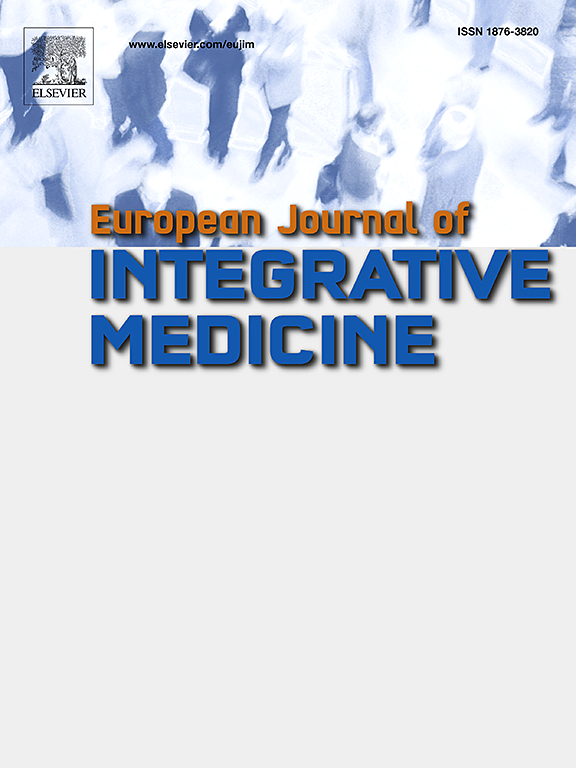探索怀孕期间补充和替代药物的使用:来自印度尼西亚的横断面研究
IF 1.7
4区 医学
Q3 INTEGRATIVE & COMPLEMENTARY MEDICINE
引用次数: 0
摘要
补充和替代医学(CAM)是指与传统医疗保健一起或代替传统医疗保健使用的疗法。怀孕期间CAM的使用已引起越来越多的关注,但在印度尼西亚对其模式和决定因素知之甚少。本研究旨在探讨怀孕妇女的CAM使用情况,确定影响因素,并评估潜在的草药-药物相互作用。方法于2023年8月至11月在印度尼西亚望加锡市某二级医院进行横断面调查。采用方便抽样的方法,招募年龄≥18岁门诊就诊的孕妇。数据收集使用有效的,结构化的问卷,评估人口特征,辅助生殖和药物使用,以及对辅助生殖的看法。利用印度尼西亚传统药物处方集和天然药物综合数据库确定潜在的草药相互作用。结果在560名答复者中,52.3%的人报告目前正在使用替代药物,其中草药是最常用的方式。与CAM使用显著相关的因素包括教育水平(p=0.021)、胎龄(p=0.016)、以前使用过CAM (p= 0.001)、家人/朋友使用CAM (p= 0.001)和同时服用处方药(p=0.003)。确定了12种潜在的草药相互作用:8种为中度相互作用,4种为轻微相互作用。结论孕妇中草药替代疗法的高使用率突出了卫生保健提供者在安全使用和潜在的中草药相互作用方面提供指导的必要性。本文章由计算机程序翻译,如有差异,请以英文原文为准。
Exploring the use of complementary and alternative medicine during pregnancy: A cross-sectional study from Indonesia
Introduction
Complementary and alternative medicine (CAM) refers to therapies used alongside or in place of conventional medical care. CAM use during pregnancy has gained increasing attention, yet little is known about its patterns and determinants in Indonesia. This study aimed to explore CAM use among pregnant women, identify influencing factors, and assess potential herb-drug interactions.
Methods
A cross-sectional survey was conducted from August to November 2023 at a secondary hospital in Makassar, Indonesia. Pregnant women aged ≥ 18 years attending outpatient clinic were recruited through convenience sampling. Data were collected using a validated, structured questionnaire that assessed demographic characteristics, CAM and medication use, and perceptions of CAM. Potential herb-drug interactions were identified using the Indonesian Traditional Medicine Formulary and the Natural Medicines Comprehensive Database.
Results
Of the 560 respondents, 52.3 % reported currently using CAM, with herbal medicines being the most commonly used modality. Factors significantly associated with CAM use included educational level (p=0.021), gestational age (p=0.016), prior CAM use (p<0.001), CAM use among family/friends (p<0.001), and concurrent prescribed medications (p=0.003). Twelve potential herb-drug interactions were identified: eight were classified as moderate and four as minor interactions.
Conclusion
The high prevalence of CAM use among pregnant women highlights the need for healthcare providers to offer guidance on safe use and potential herb-drug interactions.
求助全文
通过发布文献求助,成功后即可免费获取论文全文。
去求助
来源期刊

European Journal of Integrative Medicine
INTEGRATIVE & COMPLEMENTARY MEDICINE-
CiteScore
4.70
自引率
4.00%
发文量
102
审稿时长
33 days
期刊介绍:
The European Journal of Integrative Medicine (EuJIM) considers manuscripts from a wide range of complementary and integrative health care disciplines, with a particular focus on whole systems approaches, public health, self management and traditional medical systems. The journal strives to connect conventional medicine and evidence based complementary medicine. We encourage submissions reporting research with relevance for integrative clinical practice and interprofessional education.
EuJIM aims to be of interest to both conventional and integrative audiences, including healthcare practitioners, researchers, health care organisations, educationalists, and all those who seek objective and critical information on integrative medicine. To achieve this aim EuJIM provides an innovative international and interdisciplinary platform linking researchers and clinicians.
The journal focuses primarily on original research articles including systematic reviews, randomized controlled trials, other clinical studies, qualitative, observational and epidemiological studies. In addition we welcome short reviews, opinion articles and contributions relating to health services and policy, health economics and psychology.
 求助内容:
求助内容: 应助结果提醒方式:
应助结果提醒方式:


